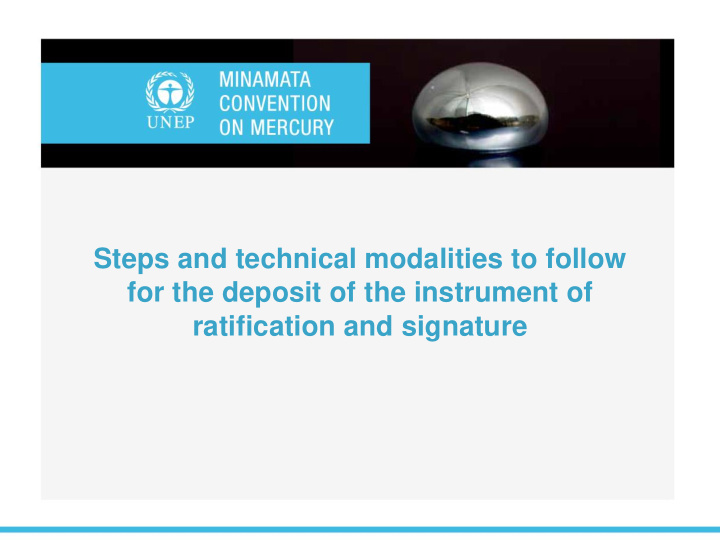



Steps and technical modalities to follow for the deposit of the instrument of ratification and signature
Signature vs ratification Signature – formal expression of intent to be bound, but no legal obligation yet: however, a State is obliged to refrain from acts which would defeat the object and purpose of a treaty once it has signed, even if it has not yet entered into force (customary law and 1969 Vienna Convention on the Law of Treaties). In the case of Minamata Convention, signature is subject to ratification (or approval, or acceptance). Ratification (or approval, or acceptance) refers to the act whereby a State establishes its consent to be bound by the Convention at the international level. Accession , after the closure of signature.
Signing the Convention (article 29) Expresses the intention of a State to become a party while not prejudging ratification The Convention is open for signature until 9 October 2014 at the UN headquarters in New York by Heads of States or Governments, Ministers of Foreign Affairs, or representatives with Full Powers issued by the above authorities For signature, make appointment with UN Treaty Section at New York. Eligibility criteria to access GEF funding pertaining to enabling activities for the Minamata Convention
Ratification process Usually ratification involves two distinct procedural acts : The first is related to the constitutional (internal) laws of a State. It involves the procedure that must be fulfilled before the state can assume the international obligations enshrined in the international agreement. In many instances this involves approval by the national parliament. The second element deals with the external (international) level . It is the process through which the State indicates its consent to be bound by the Convention.
Becoming a Party (article 30) Requires deposit of an instrument of ratification , acceptance, approval, accession with the Depositary , the UN Secretary General Ratification, acceptance, approval, accession - similar means by which a State establishes its consent to be bound by a treaty, depending on domestic legal or policy requirements Entry into force for a country : upon entry info force of the Convention (if ratification prior to the 50th instrument deposited) or 90 days after deposit date of its instrument
UN Treaty Section Handbook Available in the 6 UN languages on the UN Treaty section website https://treaties.un.org/pages/Publications.asp x?pathpub=Publication/TH/Page1_en.xml Sets out general steps for expressing the consent to be bound by a treaty Provides model instruments of Full Powers, ratification, acceptance, approval, accession and declaration
Key steps of becoming a party Step 1 : National situation analysis (e.g. cost benefit) and collection of information, such as any legislative or administrative actions necessary for implementation Step 2 : National arrangements (policy coordination, legislation, institutional arrangements) Step 3 : Contact authority responsible for issuing the instrument of ratification and identify the signatory of the instrument (Head of State or Government or Minister of Foreign Affairs) Step 4 : Identify and undertake the processes leading to endorsement of the ratification, acceptance, approval or accession
Key steps of becoming a party Step 5: Determine if any declarations or statements should be added to the instrument, including possible notification as per Article 3, registrations for exemptions from the phase out dates listed in Annex A and B as per Article 6 and information on its measures to implement the Convention as per Article 30 Step 6: Prepare and sign the instrument Step 7: Deposit instrument with the Depositary
Key steps for instrument deposit 1. Prepare instrument of ratification, acceptance, approval or accession as applicable 2. E-mail or fax copy to the UN Treaty Section (New York) for review, preferably including a translation into English or French, where appropriate. 3. Deliver the original instrument by hand or mail to the Treaty Section - Full Powers are not required for the person delivering the instrument 4. If the instrument is e-mailed or faxed for immediate deposit, deliver the original instrument to the Treaty Section as soon as possible thereafter.
Key steps of becoming a party
Recommend
More recommend